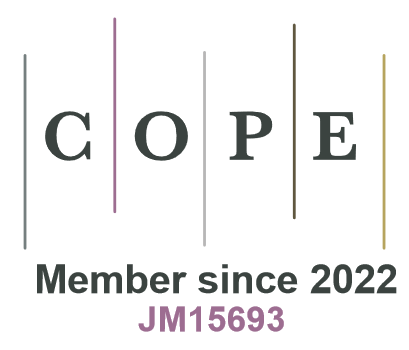Asymmetry patterns are associated with body size and somatic robustness among adult !Kung San and Kavango people
DOI:
https://doi.org/10.2478/anre-2019-0004Keywords:
directional asymmetry, fluctuating asymmetry, adult body height, somatic robustness, growth, !Kung San, KavangoAbstract
Asymmetry of bilateral anatomical structures is widely found in nature. Fluctuating asymmetry, i.e. mostly tiny random deviations from perfect symmetry in bilateral structures, is mainly interpreted within the framework of developmental instability. This interpretation is mainly due to the fact, that higher fluctuating asymmetry is often found in association with various pathological conditions but also from increased stress during somatic development. Directional asymmetry, in contrast, describes a distinct pattern of bilateral variation in a group of individuals, characterized by the tendency to find the larger side mainly at the same side for all individuals. This kind of asymmetry is mostly caused by behavioral lateralization. Somatic stress during development affect not only asymmetry patterns, it is has also an adverse effect on somatic growth. Therefore, the present study tested the hypothesis, that increased asymmetry is associated with decreased body height as well as postcranial length and robustness dimensions. The association patterns between fluctuating as well as directional asymmetry and parameters of somatic growth and robustness are analyzed among 236 !Kung San and 248 Kavango people of Namibia between the ages of 18 and 65 years. Fluctuating asymmetry was determined by ear length and ear breadth. Directional asymmetry was determined by hand length and hand breadth dimensions. Fluctuating as well as directional asymmetry correlated significantly negatively with body height and length dimensions, the correlations however, were weak. The results are interpreted as a corroboration of the theory that developmental stress may increase fluctuating asymmetry but on the other hand may decrease body size.
Downloads
References
Auerbach BM, Ruff CB. 2006. Limb bone bilateral asymmetry: variability and communality among modern humans. J Hum Evolution 50: 203–18.
View in Google Scholar
Bass SL, Saxon L, Daly RM, Turner CH, Robling AG, Seeman E, Stuckey S 2002. The effect of mechanical loading on the size and shape of bone in pre-, peri- and post pubertal girls: a study in tennis players. J Bone Mineral Res 17:2274–80.
View in Google Scholar
Battles HT. 2009. Long bone bilateral asymmetry in the nineteenth-century Stirrup court cemetery collection from London, Ontario. Canad Student J Anthrop 21:1–15.
View in Google Scholar
Benderlioglu Z, Sciulli PW, Nelson RJ. 2004. Fluctuating asymmetry predicts human reactive aggression. Am J Hum Biol 16:458–69.
View in Google Scholar
Brown WM, Price ME, Kang J, Pound N, Zhao Y, Yu H. 2008. Fluctuating asymmetry and preferences or sex-typical bodily characteristics. Proc Natl Acad Sci USA 105:12938–43.
View in Google Scholar
Christiansen K. 1991. Sex hormone levels, diet, alcohol consumption in Namibian Kavango males. Homo 42:43–62.
View in Google Scholar
Christiansen K.1992. Serum and saliva sex hormone levels in !Kung San men. Am J Phys Anthrop 86:37–44.
View in Google Scholar
Christiansen K, Winkler EM. 1992. Hormonal, anthropometrical and behavioral correlates of physical aggression in !Kung San men of Namibia. Aggressive Behav 18:271–80.
View in Google Scholar
Cuk T, Leben-Seljak P, Stefancic M.2001. Lateral asymmetry of human long bones. Variabil Evol 9:19–32.
View in Google Scholar
Datta Banik S, Ghritlahre M, Das S, Bose K. 2015. Fluctuating asymmetry of hand and foot dimensions among University girl student from Bilaspur, India. Hum Biol Rev 4:378–86.
View in Google Scholar
Deaton A. 2007. Height, health, and development. Proc Natl Acad Sci USA 104:13232–37.
View in Google Scholar
Faurie C, Schiefenhövel W, Le Bomin S, Billiard S, Raymond M. 2005. Variation in the frequency of left handedness in traditional societies. Curr Anthrop 46:142–7.
View in Google Scholar
Fink B, Weege B, Manning JT, Trivers R. 2014. Body symmetry and physical strength in human males. Am J Hum Biol 26:697–700.
View in Google Scholar
Fink B, Manning JT, Neave N, Grammer K. 2004. Second to fourth digit ratio and facial asymmetry. Evol Hum Behav 25:125–132.
View in Google Scholar
Flegr J, Hruskova M, Novotna M, Hanusova J. 2005. Body height, body mass index, waist-hip ratio, fluctuating asymmetry and second to fourth digit ratio in subjects with latent toxoplasmosis. Parasitology 130:621–8.
View in Google Scholar
Graham JH, Raz S, Hel-Ör H, Nevo E. 2010. Fluctuating asymmetry: methods, theory, and applications. Symmetry 2:466–540.
View in Google Scholar
Gray PB, Marlowe F. 2002. Fluctuating asymmetry of a foraging population: the Hadza of Tanzania. Ann Hum Bio 29:495–501.
View in Google Scholar
Haapasalo H, Kontulaine, S, Sievänen JP, Järvinen M, Vouri I. 2000. Exercise induced bone gain is due to enlargement in bone size without a change in volumetric bone density: a peripherial quantitative computed tomography study of upper arms of male tennis players. Bone 27:351–7.
View in Google Scholar
Hardman K. 2004. The relationship of fluctuating asymmetry and malnutrition in children age 0–5 years in hill tribe villages of northern Thailand. J Biol Res 7 (Abstract).
View in Google Scholar
Hoover KC, Matsumura H. 2008. Temporal variation and interaction between nutritional and developmental instability in prehistoric Japanese populations. Am J Phys Anthropol 37:469–78.
View in Google Scholar
Ireland A, Maden-Wilkinson T, Ganse B, Degens H, Rittweger J. 2014. Effects of age and starting age upon side asymmetry in the arms of veteran tennis players: a cross-sectional study. Osteoporos Int 25:1389–1400.
View in Google Scholar
Jaskulska E. 2009. Skeletal bilateral asymmetry in a medieval population from Deir an-Naqlun (Nekloni), Egypt. Bioarcheol Near East 3:17–26.
View in Google Scholar
Jones D, Hill K. 1993. Criteria of facial attractiveness in five populations. Human Nature 4: 271–96.
View in Google Scholar
Karlberg J, Luo ZC. 2000. Foetal size to final height. Acta Paediatr 89:632–36.
View in Google Scholar
Kirchengast S, Winkler EM. 1995. Differential reproductive success and body dimensions in Kavango males from urban and rural areas in northern Namibia. Hum Biol 67:291–309.
View in Google Scholar
Kirchengast S, Winkler EM. 1996a. Differential fertility and body build in !Kung San and Kavango females from northern Namibia. J Biosoc Sci 28:193–210.
View in Google Scholar
Kirchengast S, Winkler EM. 1996b. Nutritional status as indictor for reproductive success in !Kung San and Kavango females from Namibia. Anthrop Anz 54:267–76.
View in Google Scholar
Kirchengast S. 2017. Directional and fluctuating asymmetry among !Kung San and Kavango people of northern Namibia: The impact of sex and subsistence patterns. Am J Hum Biol doi: 10.1002/ajhb.22921.
View in Google Scholar
Kirchengast S, Christiansen K. 2018. Androgen levels an body size are associated with directional as well as fluctuating asymmetry patterns in adult !Kung San and Kavango males from northern Namibia. Symmetry 9:72.
View in Google Scholar
Klingenberg CP. 2003. A developmental perspective on developmental instability: Theory, models, and mechanism. In. Developmental instability: Causes and consequences. Polak, M. (Editor) Oxford University Press. Oxford. UK pp 1–34.
View in Google Scholar
Knussmann R. 1988. Somatometrie. In Anthropologie, R Knussmann, editor. Germany: Gustav Fischer Verlag Stuttgart. pp 232–285.
View in Google Scholar
Kontulainen S, Sievänen H, Kannus P, Pasanen M, Vuori I. 2003. Effect of long-term impact loading on mass, size, and estimated strength of humerus and radius of female racquet-sports players: a peripheral quantitative computed tomography study between young and old starters and controls. J Bone Miner Res 18: 352–359.
View in Google Scholar
Krahl H, Michaelis U, Pieper HG, Quack G. 1994. Montag, M. Stimulation of bone growth through sports – a radiologic investigation of the upper extremities in professional tennis players. Am J Sport Med 22:751–57.
View in Google Scholar
Lazenby RA. 2002. Skeletal biology, functional asymmetry and the origins of handedness. J theor Biol 218:129–38.
View in Google Scholar
Leung B Forbes MR, Houle D. 2000. Fluctuating asymmetry as a bio-indicator of stress: comparing efficacy of analyses involving multiple traits. Am Naturalist 155:101–15.
View in Google Scholar
Little BB, Buschang PH, Malina M. 2002. Anthropometric asymmetry in chronically undernourished children from Southern Mexico. Ann Hum Biol 29:526–37.
View in Google Scholar
Little AC, Jones BC, Waitt C, Tiddeman BP, Feinberg DR, Perrett DL, Apicella CL, Marlowe FW. 2008. Symmetry is related to sexual dimorphism in faces: data across culture and species. Plosone, 3: e2106.
View in Google Scholar
Livshits G, Yakovenko K, Kletselman L, Karasik D, Kobyliansky E. 1998. Fluctuating asymmetry and morphometric variation of hand bones. Am J Phys Anthropol 107:125–36.
View in Google Scholar
Lozano M, Mosquera M, Bermudez de Castro JM, Arsuaga JL, Carbonell E. 2009. Right handedness of Homo heidelbergensis from Sima de los Huesos (Atapuerca, Spain) 500 000 years ago. Evol Hum Behav 30:369–76.
View in Google Scholar
Manning JT. 1995. Fluctuating asymmetry and body weight in men and women. Implications for sexual selection. Ethol Sociobiol, 16: 145–153.
View in Google Scholar
Manning JT, Koukourakis K, Brodie DA. 1997. Fluctuating asymmetry, metabolic rate and sexual selection in human males. Evol Hum Behav 18:15–21.
View in Google Scholar
Manning JT, Scutt D, Lewis-Jones DI. 1998. Developmental stability, ejaculate size, and sperm quality in men. Evol Hum Behav 19:273–82.
View in Google Scholar
Manning JT, Fink B, Neave N, Szwed A. 2009. The second to fourth digit ratio and asymmetry. Ann Hum Biol 36:186–98.
View in Google Scholar
McManus IC, Moore J, Freegard M, Rawles R. 2010. Science in the making: Right hand, left hand III: Estimating historical rates of left-handedness. Laterality 15:186–208.
View in Google Scholar
Milne BJ, Belsky J, Poulton R, Thomson WM, Caspi A, Kieser J. 2003. Fluctuating asymmetry and physical health among young adults. Evol Hum Behav 24:53–63.
View in Google Scholar
Moller AP. 2006. A review of developmental instability, parasitism and disease infection, genetics and evolution. Infect Genet Evol 6:133–40.
View in Google Scholar
Moller AP, Sanotra GS, Vestergaard KS. 1995. Developmental stability in relation to population density and breed of Chicken Gallus gallus. Poul Sci 74:1761–71.
View in Google Scholar
Özener B. 2010. Fluctuating and directional asymmetry in young human males: effect of heavy working condition and socioeconomic status. Am J Phys Anthrop 143:112–20.
View in Google Scholar
Özener B, Ertuğrul B. 2011. Relationship between shortness of final body height and fluctuating asymmetry in Turkish young males. Ann Hum Biol 38:34–8.
View in Google Scholar
Özener B, Graham JH. 2014. Growth and fluctuating asymmetry of human newborns: Influence of inbreeding and parental education. Am J Phys Anthrop 152: 45–51.
View in Google Scholar
Palmer AR, Strobeck C. 1986. Fluctuating asymmetry: measurement, analysis, patterns. Ann Rev Ecol Systematics 17:391–421.
View in Google Scholar
Palmer AR, Strobeck C. 2003. Fluctuating asymmetry analysis revisted. In: Developmental instability: causes and consequences, M Polak editor. Oxford: Oxford University Press. pp. 279–319.
View in Google Scholar
Peters M. 1988. Footedness: Asymmetries in Foot Preference and Skill and Neuropsychological Assessment of Foot Movement. Psychol Bull 103:179–92.
View in Google Scholar
Pickering TR, Hensley_Marschand B. 2008. Cutmarks and hominid handedness. J Archeol Sci 35:310–15.
View in Google Scholar
Prieto MT, Campo JL, Santiago-Moreno J. 2011. Relationship among fluctuating asymmetry, morphological traits and sperm quality in layers. Poultry Science 90:2845–54.
View in Google Scholar
Reeves NM, Auerbach BM, Sylvester AD. 2016. Fluctuating and directional asymmetry in the long bones of captive Cotton-top Tamarins (Saguinus Oedipus). Am J Phys Anthrop 160: 41–51.
View in Google Scholar
Ruel MT, Rivera J, Habicht JP, Martorell R. 1995. Differential response to early nutrition supplementation: Long-term effects on height at adolescence. Int J Epidemiol 1(24):404–12.
View in Google Scholar
Sarringhaus LA, Stock JT, Marchant LF, Mc-Grew WC. 2005. Bilateral asymmetry in the limb bones of the chimpanzee (Pan troglotydes). Am J Phys Anthrop 128:840–45.
View in Google Scholar
Schäfer K, Lauc T, Mitteröcker P, Gunz P, Bookstein FL.2006. Dental arch asymmetry in an isolated Adriatic community. Am J Phys Anthropol 129: 132–142.
View in Google Scholar
Spur GB, Reina JC, Barac-Nieto M. 1986. Marginal malnutrition in school-aged Colombian boys: Metabolic rate, and estimated daily energy expenditure. Am J Clin Nutr 44:113–26.
View in Google Scholar
Steele J. 2000. Handedness in past populations skeletal markers. Laterality 5:193–220.
View in Google Scholar
Steele J, Mays S. 1995. Handedness and directional asymmetry in the long bones of the human upper limb. Int J Osteoarcheol 5:39–49
View in Google Scholar
Thornhill R, Moller AP. 1998. The relative importance of size and asymmetry in sexual selection. Behav Ecol 9:546–51.
View in Google Scholar
Udani PM. 1992. Protein energy malnutrition (PEM), brain and various facets of child development. Indian J Pediatr 59:165–86.
View in Google Scholar
Uomini NT. 2009. The prehistory of handedness: Archeological data and comparative ethology. J Hum Evol 57:411–19.
View in Google Scholar
Van Dongen S. 2018. Human bodily asymmetry relates to behavioral lateralization and may not reliably reflect development instability. Symmetry 10(4):117. doi:10.3390/sym10040117.
View in Google Scholar
Van Dongen SV. 2006. Fluctuating asymmetry and developmental instability in evolutionary biology: past, present and future. The Author 19:1727–43.
View in Google Scholar
Van Dongen S. 2015. Variation in measurement error in asymmetry studies: a new model, simulations and application. Symmetry 7:284–93.
View in Google Scholar
Van Dongen S. 2000. Unbiased estimation of individual asymmetry. J Evol Biol 13:107–12.
View in Google Scholar
Van Valen L. 1962. A study of fluctuating asymmetry. Evolution 10:139–46.
View in Google Scholar
Waidhofer M, Kirchengast S. 2015. Sexual dimorphism in directional asymmetry of the upper limb bones among Khoe-San skeletons. Homo 66(6):508–19.
View in Google Scholar
Weiss E. 2009. Sex differences in humeral bilateral asymmetry in two hunter-gatherer populations: California Amerinds and British Columbian Amerinds. Am J Phys Anthrop 140:19–24.
View in Google Scholar
Wells JC, Hallal PC, Manning JT, Victoria CG. 2006. A trade-off between early growth rate and fluctuating asymmetry in Brazilian boys. Ann Hum Biol 33:112–24.
View in Google Scholar
Wilson JM, Manning JT. 1996. Fluctuating asymmetry and age in children: Evolutionary implications for the control of developmental stability. J Hum Evol 30:529–37.
View in Google Scholar
Winkler, E.M., Christiansen, K. 1991. Anthropometric hormonal correlation patterns in San and Kavango males from Namibia. Ann Hum Biol 18(4):341–55.
View in Google Scholar
Winkler, E.M., Christiansen, K. 1993. Sex hormone levels and body hair growth in !Kung San and Kavango men. Am J Phys Anthrop 92:155–64.
View in Google Scholar
Winkler, E.M., Kirchengast, S. 1994. Body dimensions and differential fertility in !Kung San males from Namibia. Am J Hum Biol, 6:203–13.
View in Google Scholar
Zaidi ZF. 2011. Body asymmetry: incidence, etiology and clinical implications. Austral J Basic Appl Sci 5:2157–91.
View in Google Scholar
Downloads
Published
How to Cite
Issue
Section
License

This work is licensed under a Creative Commons Attribution-NonCommercial-NoDerivatives 4.0 International License.








